Thermal imaging cameras civilian gradually warming
If you also think the camera is a high-end professional equipment, military equipment, far away from us, I am sorry, you have out! Our impression of the camera often appear in a military reconnaissance, maritime operations and other specialized operations , And now, the application of thermal imaging camera almost all around us. In recent years, with the development and popularization of hand-held infrared thermal imaging cameras, military specialized precision instruments have been gradually transformed into civilian products that are portable, intelligent, and even come with Wi-Fi / Cloud-thermal imaging. If you are worried about where the water pipes leak, cell phones or TV screens, or where the body inflammation, etc., you can surprise you: handheld thermal imager, one-stop solution to such problems, but also Upload cloud for saving, big data management.
Similarly, many industries are also changing due to the popularity of thermal imaging cameras. For example, if a firefighter has a hand-held thermal imager, it can accurately determine the location of a firearm and accurately locate the trapped person; for example, an earthquake Occurred, if the UAV with a thermal imager, you can rush through the obstacles in the first time, to identify the disaster situation, immediately found the trapped staff will not be reappeared once the first rescue workers can only "touch stone exploration Road "situation, the delay of the best rescue time; Another example, as small as ordinary shops or homes, large countries, the use of thermal imaging system security system, you can accurately determine whether there are unsafe factors; also, for example, production and processing products process Many of them are unobservable with the naked eye, and if there is a thermal imager in the detection of the precision of ordinary instruments, all the problems are "at a glance".
The applications of thermal imaging cameras are now available in every corner of our lives, from common medical imaging to the spectrum detection just around us, from the food we know to the military to the detection of radar modeling, from the most familiar security of daily life Check for upcoming autopilot, smart life.
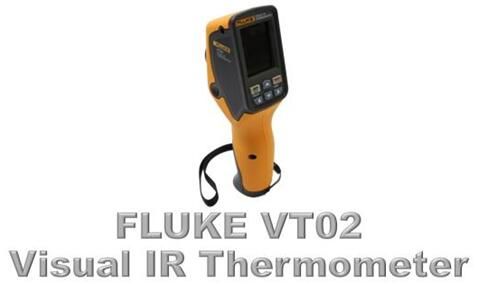
FLUKE Visual infrared thermometerVT02 is the electrical and maintenance technicians testing tools
Industrial applications of thermal imaging cameras
Perhaps you are not familiar with the industrial applications of thermal imaging cameras. Here's a brief introduction to the use of thermal imaging cameras in industrial automation: Thermal imaging cameras can be used in automated inspection, process control, condition monitoring, fire prevention and monitoring, and Continuous optical gas imaging and other five applications play an irreplaceable role.

Food production line quality control car windshield defrosting inspection

Control of automatic welding machine positioning pipelines High-voltage equipment thermal test

Hot spots on the ladle show a possible continual monitoring of the warehouse
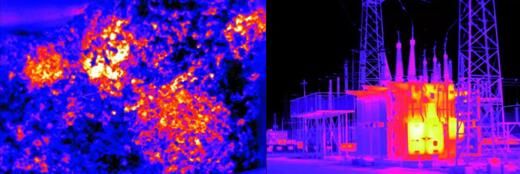
Detecting the risk of fire in the waste bunker Transformer temperature is too high
The great potential of thermal imaging cameras has ushered in the golden period of development
Once the development of infrared thermal imaging is mainly driven by the application of national defense, the latest products are also mainly used in military products. Almost a decade of development has made this phenomenon a thing of the past, and today's widespread use of thermal imaging in the firefighting, PVS, maritime, drones, robots, smart buildings, smart home and smart stores and other large-scale market development, infrared sensors The application in business is very optimistic. For example, FLIR, a leader in the thermal imaging market, has shipped 1 million Lepton caliber in just over three years from 2015 to the present, integrating more than 20 products (Lepton is a Key Infrared Movement); at the same time, FLIR has pioneered an intelligent strategy to bring uncooled infrared imaging technology into a wide range of products for a wide range of applications, enabling uncooled infrared imaging to be more widely used and gaining larger markets .
As far as China is concerned, as a high-tech industry, thermal imaging industry has broad prospects for the development of the industry. According to incomplete statistics, the potential demand of China's infrared thermal imaging market can reach 50 ~ 60 billion yuan. At present, the market condition is only in its infancy. By 2020, the market for infrared imaging will grow by more than 20%. Domestic leading companies such as high-German infrared, Dali, SATIR, Hikvision and other leaders have also witnessed rapid development in recent ten years. New products and new applications keep pace with the times.
How does an infrared camera work?
Infrared thermography is a technique that converts an infrared image into a thermal radiation image, which reads temperature from an image and is a non-destructive testing technique.
Infrared Thermal Imager is a high-tech product used to detect the infrared radiation of a target object and convert the temperature distribution image of the target object into a video image through photoelectric conversion and electrical signal processing.
How does that thermal camera work?
1. the working range of infrared thermal imager
In nature, as long as the object is higher than the absolute zero temperature (-273 ℃) can radiate electromagnetic waves. Infrared is the most widespread form of electromagnetic waves in nature, it is a kind of energy, and this energy is invisible to the naked eye. Any object under normal circumstances will produce their own molecules and atoms irregular movement, and non-stop radiation of thermal infrared energy.
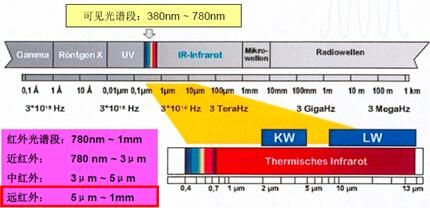
Infrared camera operating spectrum
Infrared is part of these electromagnetic waves, which together with visible light, ultraviolet light, X-rays, gamma rays and radio waves form a complete continuous electromagnetic spectrum. As shown above, electromagnetic radiation in the wavelength range of 0.78μm to 1000μm is called infrared radiation.
Infrared radiation Electromagnetic waves propagate through the air to be absorbed by the atmosphere so that the radiation energy is attenuated, and if the absorbed energy is too much, it can not be observed using a thermal imager. Atmosphere, cloud of smoke and other infrared absorption also with infrared radiation wavelength, for 3 ~ 5μm and 8 ~ 14μm infrared is transparent. Therefore, these two bands are called infrared "atmospheric window." Using these two windows, the thermal imaging camera can be observed in a normal environment without the attenuation of infrared radiation.
2. thermal imaging principle
In other words, infrared thermography is a thermal image that turns invisible infrared radiation into visible light. Different objects and even the same object in different parts of the radiation capacity and their reflection on the infrared intensity is different. Utilizing the radiation difference between the object and the background environment and the difference of the radiation of each part of the scene itself, the thermal image can show the radiation fluctuation of each part of the scene and thus can show the characteristics of the scene. The thermal image is actually the target surface temperature distribution image.
3. the composition of the infrared camera
Infrared camera's basic working principle is: Infrared through a special optical lens, is absorbed by the infrared detector, the detector will vary in intensity of the infrared signal into electrical signals, and then through the enlargement and video processing, the formation of available The thermal image observed by the human eye is displayed on the screen. The camera consists of two basic parts: the optical system and the detector.
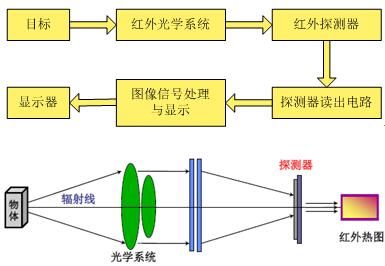
Infrared camera working principle diagram
The camera is very sensitive and can detect temperature differences of less than 0.1 ° C. For example, the FLIR thermal imaging camera can detect subtle changes in temperature to 0.02 ° C, advanced detection technology and advanced mathematical algorithms to accurately measure the temperature of an object from -40 ° C to + 2000 ° C.
4. classification of thermal imaging cameras
* According to the working temperature can be divided into refrigeration / non-refrigeration
Cooling thermal imaging, the detector integrates a cryogenic refrigerator, this device can give the detector temperature, so that the thermal noise signal is lower than the imaging signal, the imaging quality is better.
Uncooled thermal imager, the detector does not require low-temperature cooling, the detector is usually based on microbolometer based, mainly polycrystalline silicon oxide and vanadium two detectors.
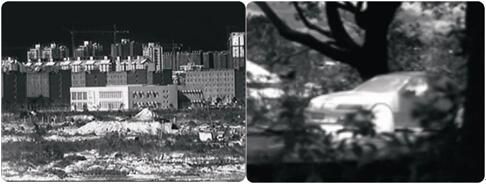
Cooled thermal imaging (left) and uncooled thermal imaging (right) imaging
* According to the function can be divided into temperature measurement / non-temperature measurement type
Temperature-type thermal imaging camera, the thermal image can be read directly from the surface temperature of any point on the surface, this system can be used as non-destructive testing instruments, but the effective distance is relatively short.
Non-temperature-type thermal imaging cameras can only observe the difference of heat radiation on the surface of the object. Such a system can be used as an observation tool and the effective distance is relatively long.

Thermal image with temperature information Thermal image without temperature information
Infrared camera heart - infrared detector
Infrared detectors from the detection mechanism can be divided into: infrared photon detectors and infrared detectors.
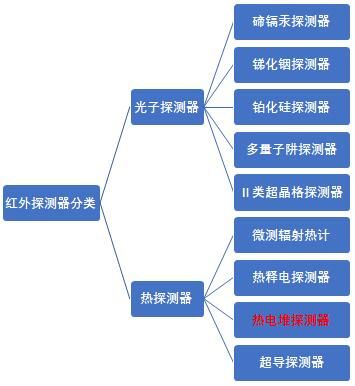
Specific classification of infrared detectors
1, Photon Detector: The basic working principle is that when the detector absorbs photons of target or background radiation, the electrons in the outermost shell of the detector material undergo transition to form free electrons in the crystal to generate photoconductive or photovoltaic effect. The intensity of photoconductivity and photovoltaic effect depends on the radiation intensity of the radiation source and the sensitivity of the detector. During the entire exploration work, the photon detector temperature remained essentially constant.
2. the heat detector: mainly through the absorption of infrared radiation energy, the detector temperature changes, causing the detector resistivity or polarity changes, heat detector resistivity or change in the amount of electrode polarity also depends on the radiation source The radiation intensity and detector sensitivity.
3.Comparison of Two Types of Infrared Detectors: Due to their different working mechanisms, these two types of detectors show different infrared response characteristics: the photon detector has the best response wavelength (peak wavelength), blackbody response rate and peak value The difference in response rates varies widely with the detector response band; however, the response of a heat detector changes almost flat with wavelength. Therefore, the heat detector blackbody response and peak response almost no difference. On the other hand, as detectors operate at higher temperatures, heat detectors can have higher sensitivity than photodetectors. Therefore, it is usually widely used in operating temperature near room temperature, which is called "uncooled" detector.

An example of an infrared detector operating at room temperature is a cadmium telluride semiconductor operating at low temperatures
4. infrared thermopile detector
Although compared to other infrared detectors, infrared thermopile detectors with low response sensitivity and long thermal response time do not provide competitive advantages in device performance. However, the thermopile detector is easy to manufacture compatible with the integrated circuit technology, the signal post-processing circuit is also relatively simple, with the potential of low cost, community security, safety monitoring, and car-assisted driving have less application of infrared imaging image quality prospect. So below specifically for everyone to introduce the infrared thermopile detector.
An infrared thermopile detector is a type of infrared heat detector. The thermopile is made up of a series of thermocouples connected in series and has a greater output thermoelectric power than a thermocouple. Previous infrared thermopile detector is the use of mask vacuum coating method, the thermocouple material deposited on plastic or ceramic substrate obtained, but the device size larger, and not easy to mass production. With the vigorous development of microelectronic technology, the concept of microelectromechanical system (MEMS) is put forward, and then a micro-mechanical infrared thermopile detector is developed.
The infrared thermopile operates on the Seebeck effect: If two different materials or materials have the same work function A and B, and are connected at the hot junction, there is a temperature difference dT between the hot junction and the cold junction , Then the cold junction between the two beams will have an open circuit potential dV. To improve the performance of the detector, the ideal thermocouple material should be characterized by a combination of low thermal conductivity, high conductivity and high Seebeck coefficients, but in fact these factors also affect each other, defined by a quality factor Z.

Seebeck effect diagram (A and B in the figure constitute a pair of thermocouples)
Infrared thermopile sensor applications are: the field of health (ear thermometer, the amount of temperature guns, pressure sensors, baby incubators, etc.), industrial areas (temperature guns, copiers, overheating protection, such as transformer boxes), security (Such as abnormal temperature screening), household appliances (microwave oven, induction cooker, cooker, hairdryer, dryer, electric heater, etc.), lighting (LED control switch), automotive (car air conditioner and exhaust).
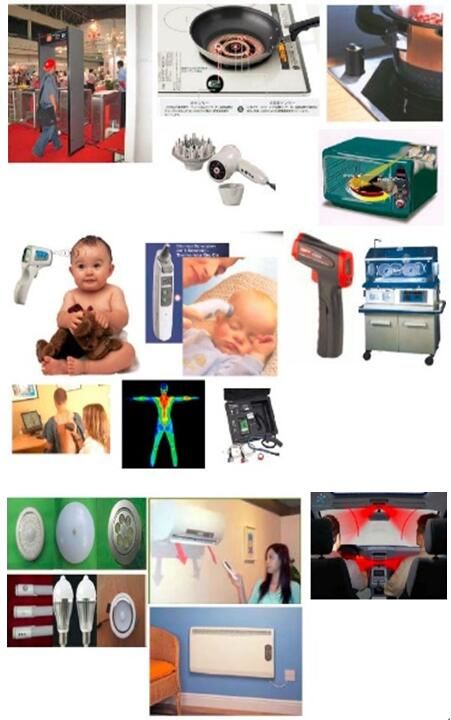
Infrared thermopile sensors a large number of applications
If you have any questions regarding our products or services, please feel free to contact us.
Get in Contact with Our Sales Team